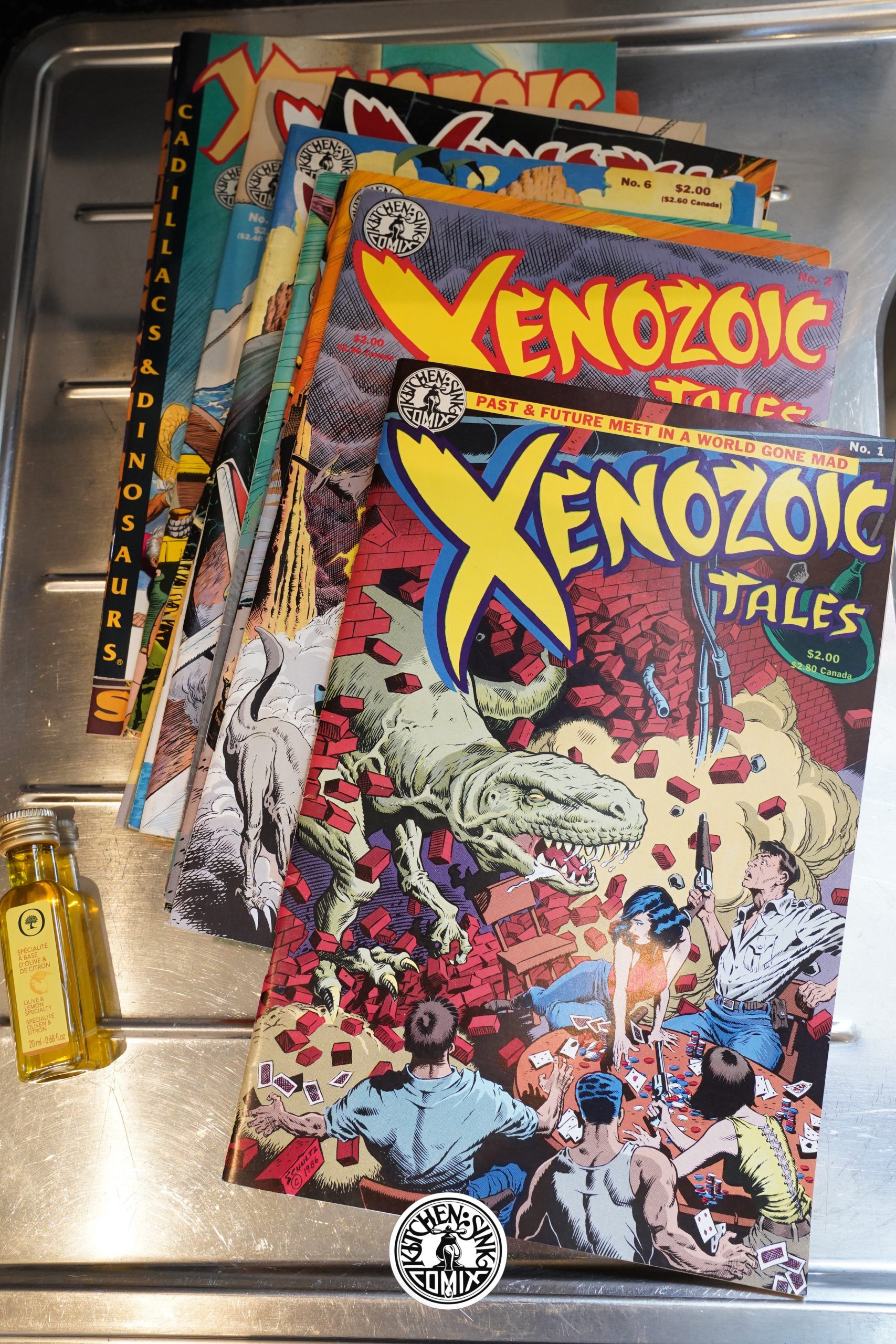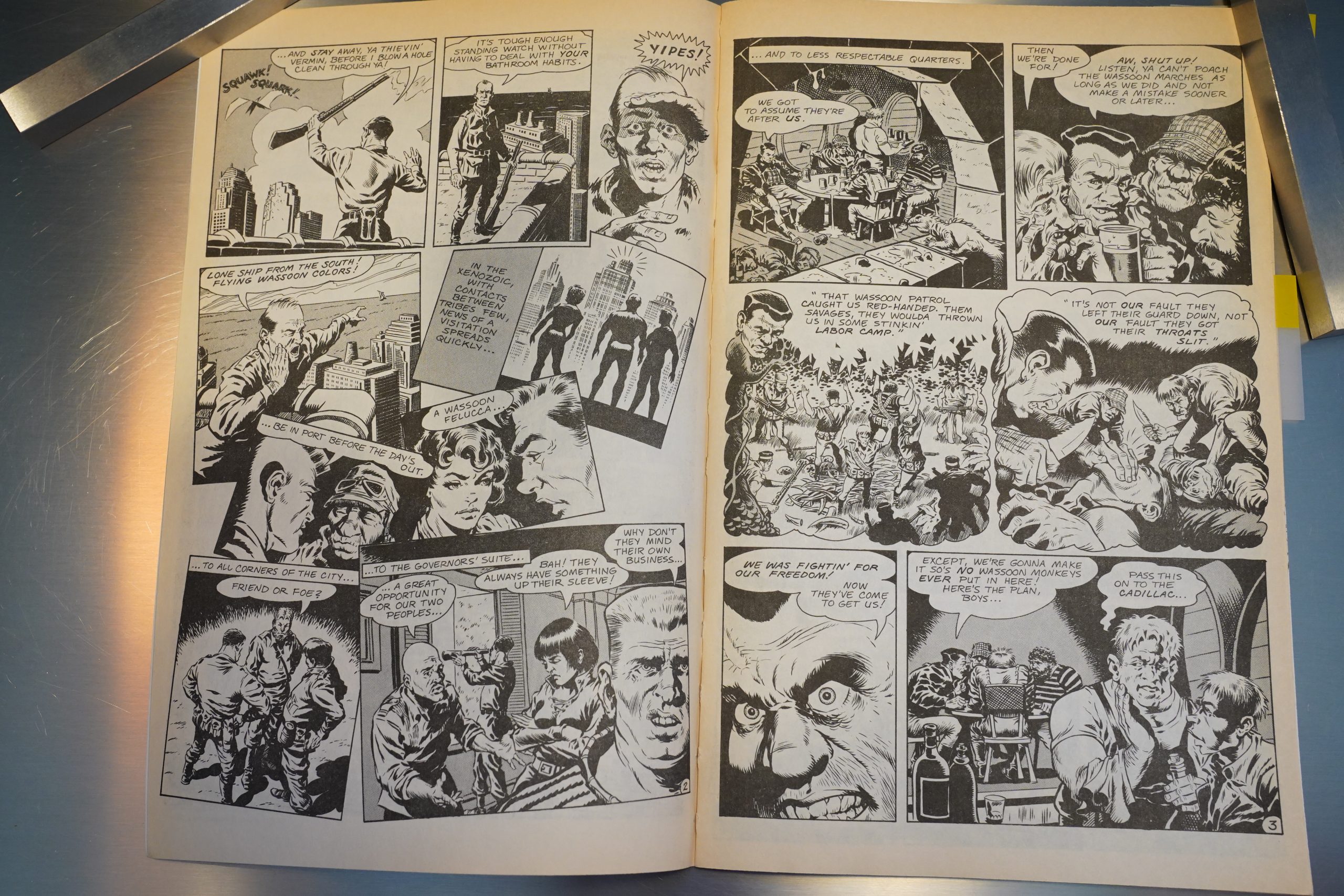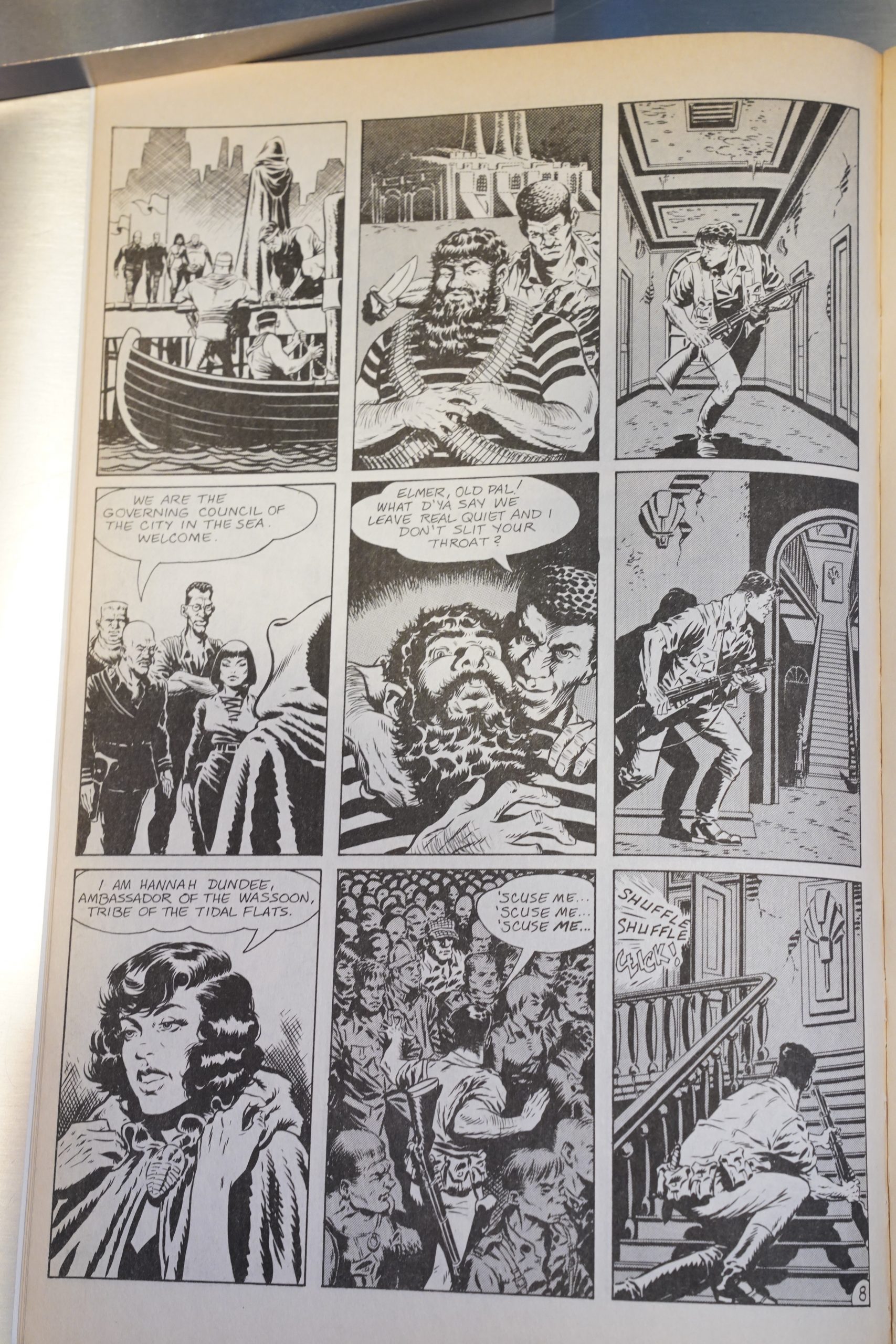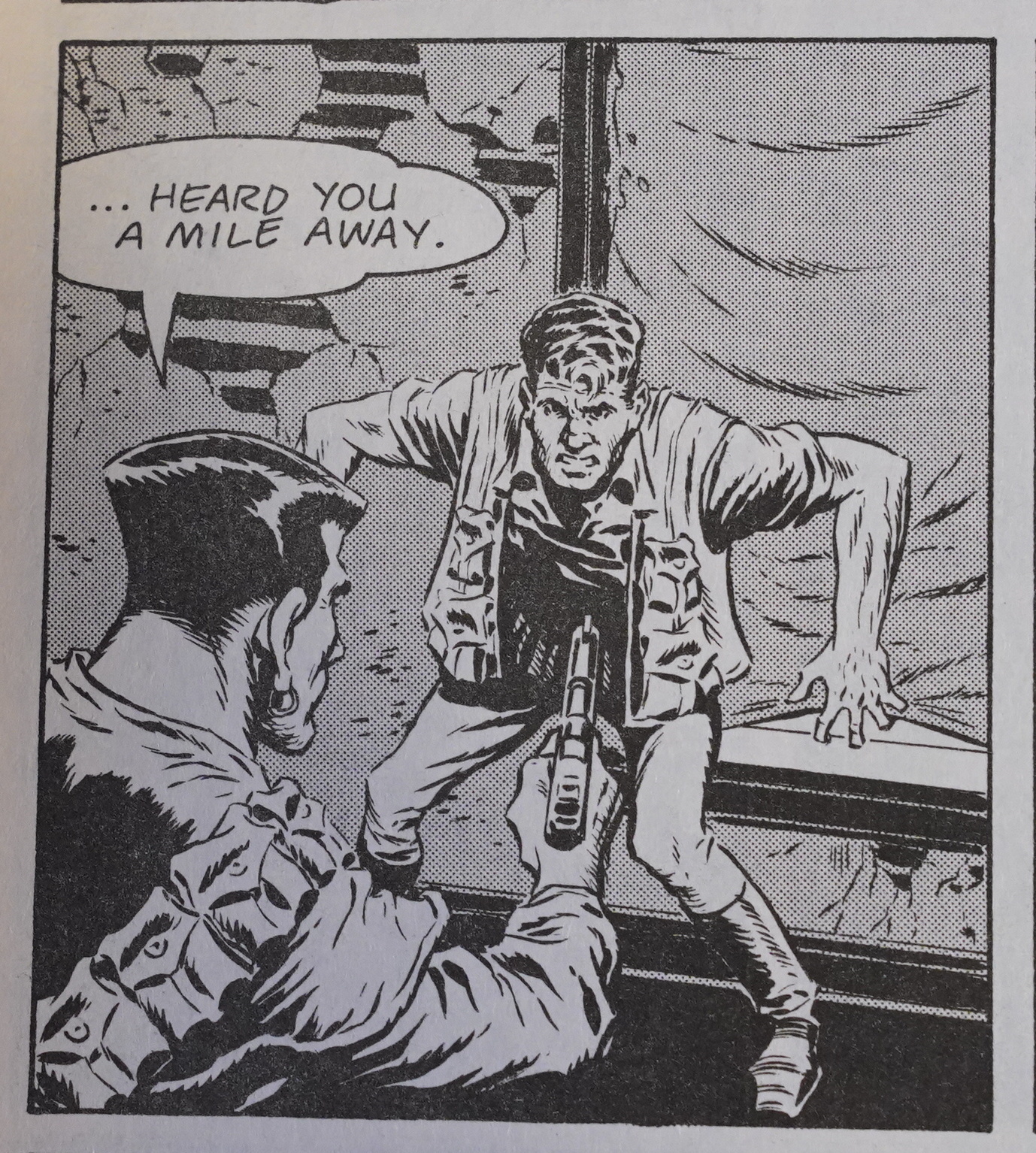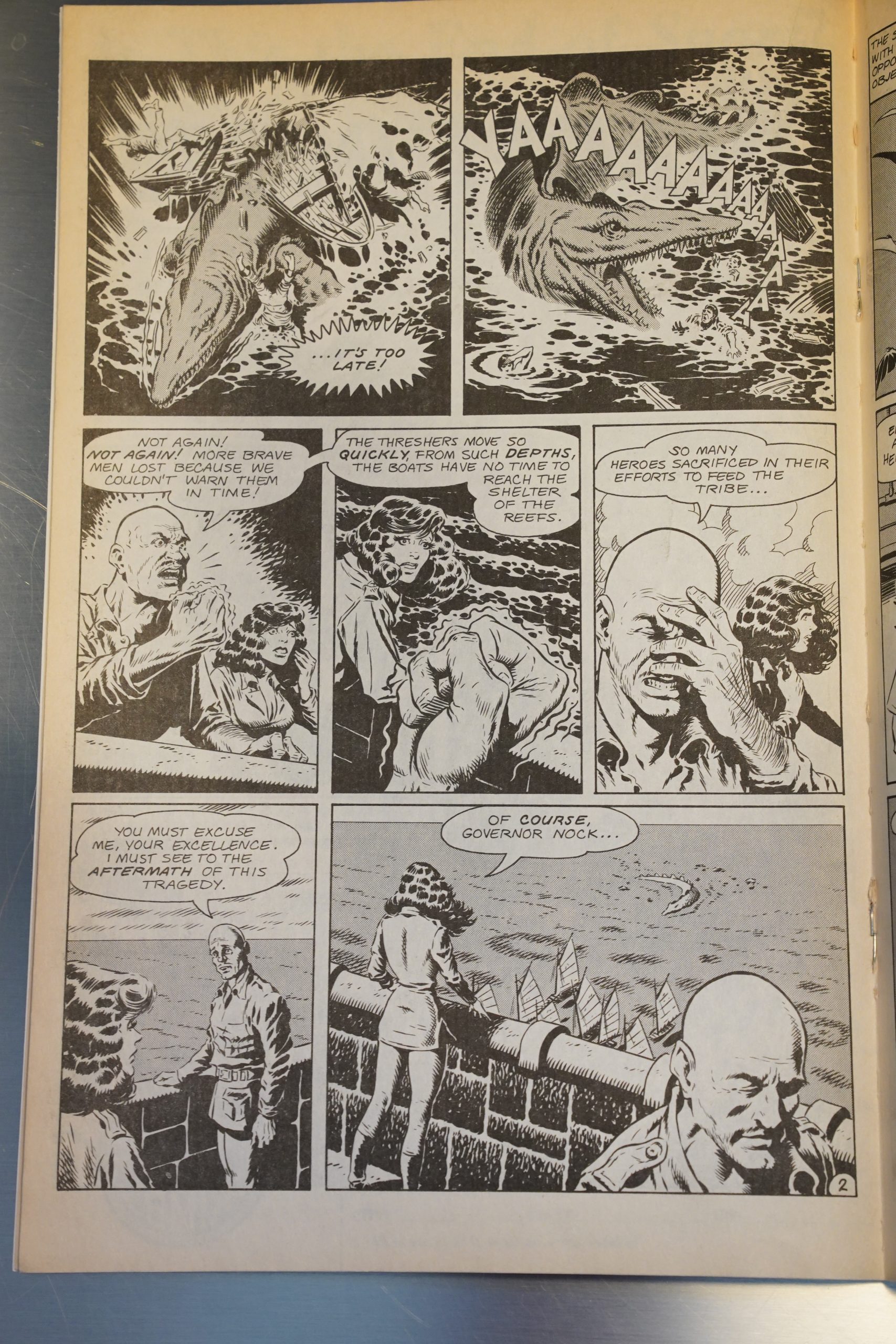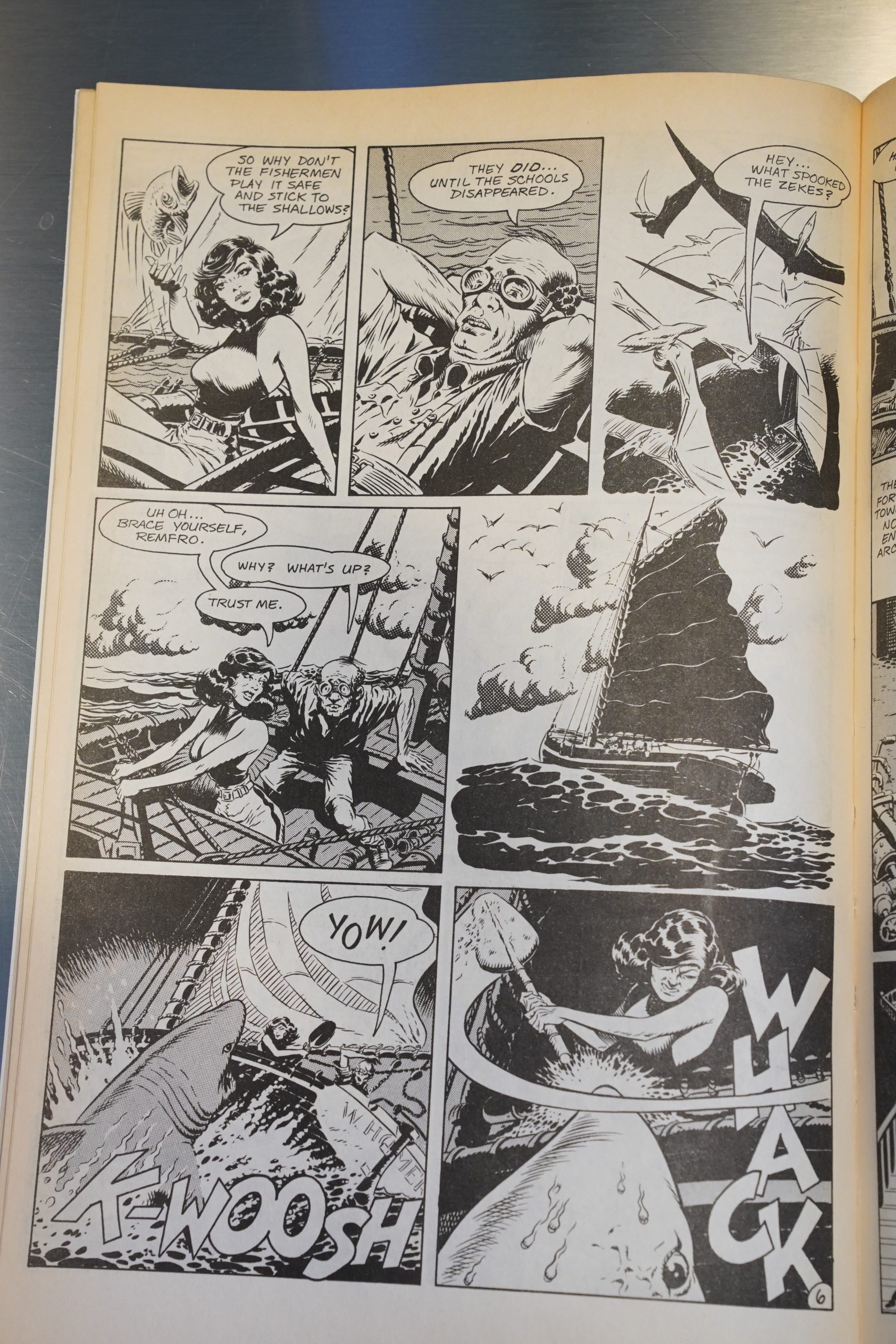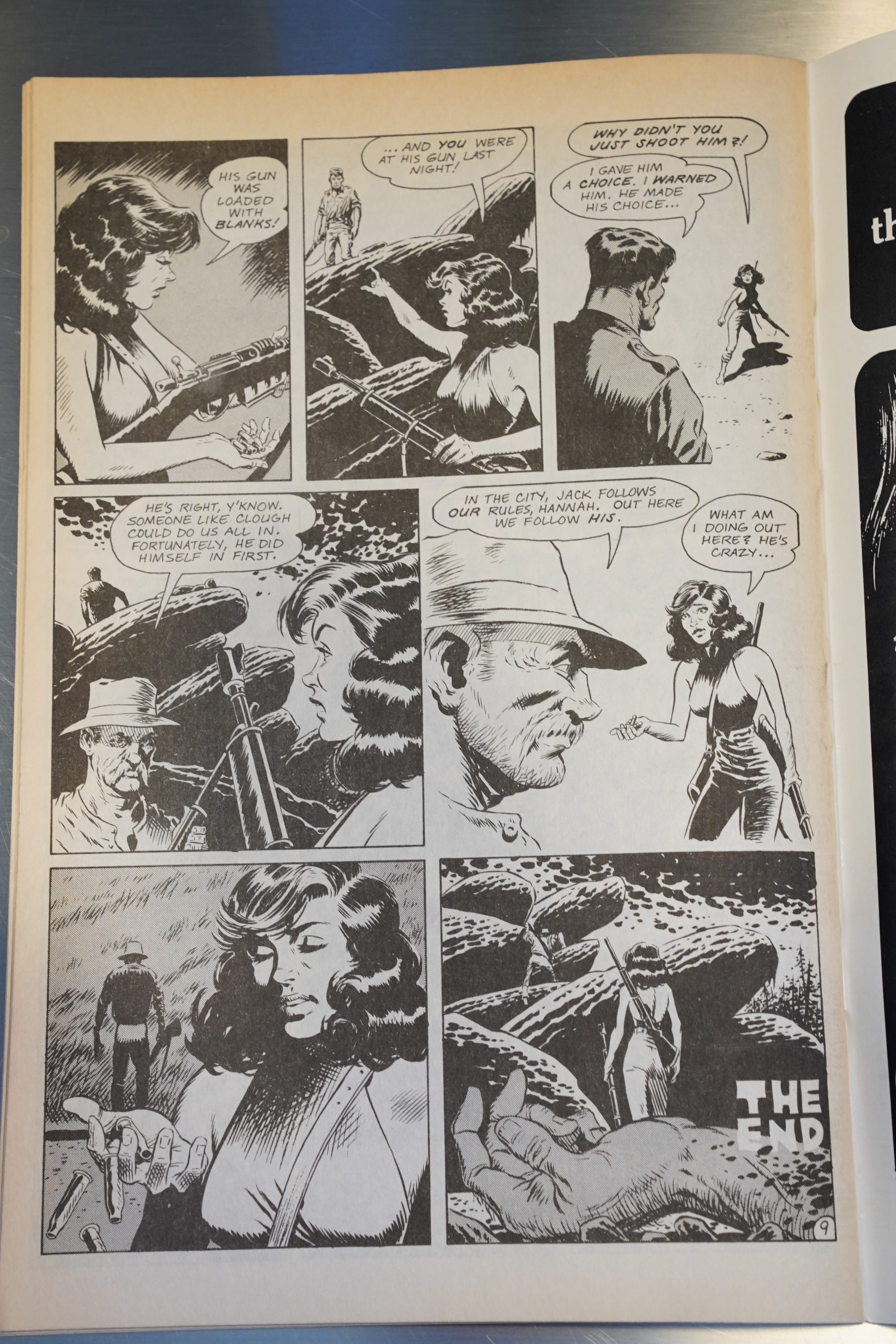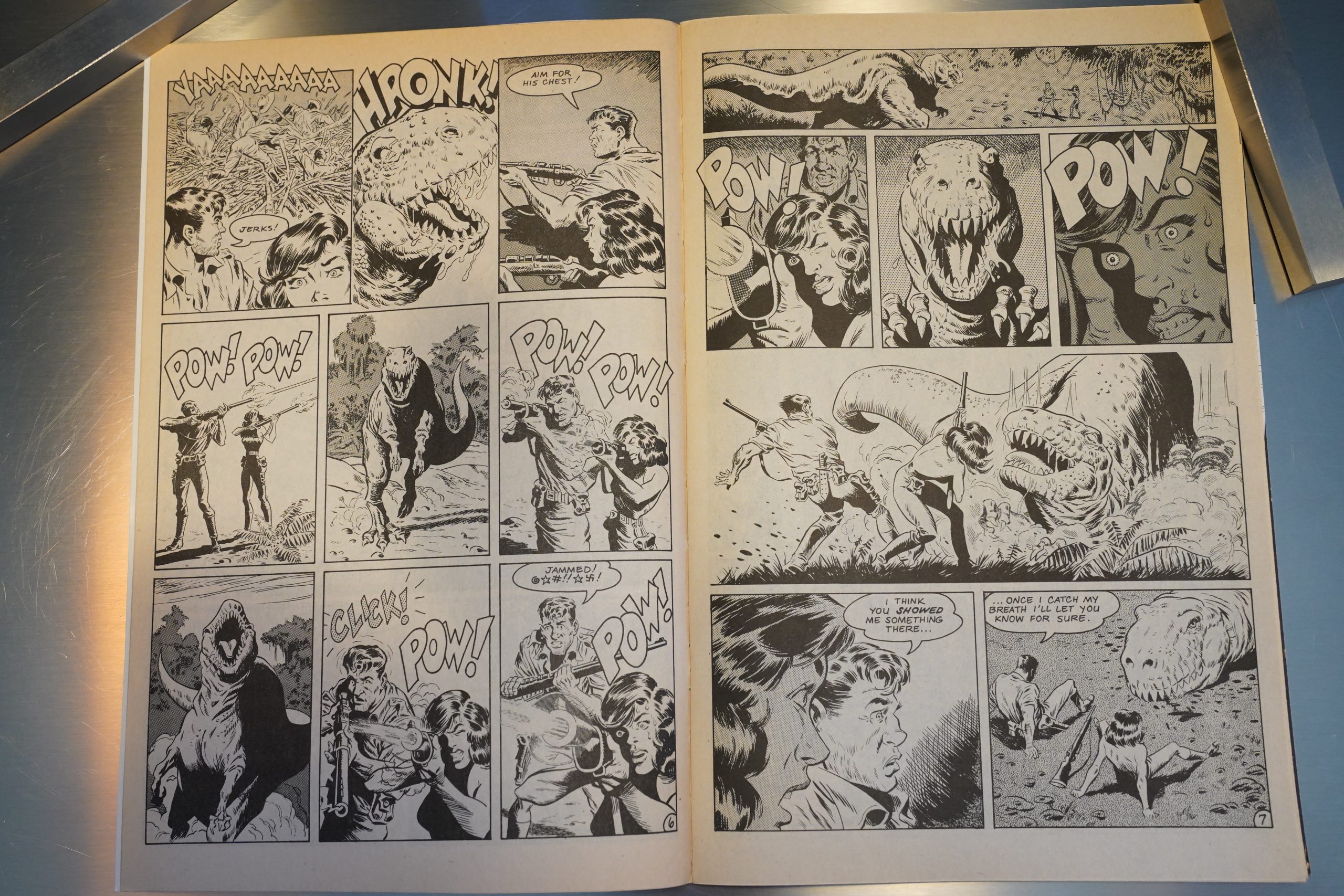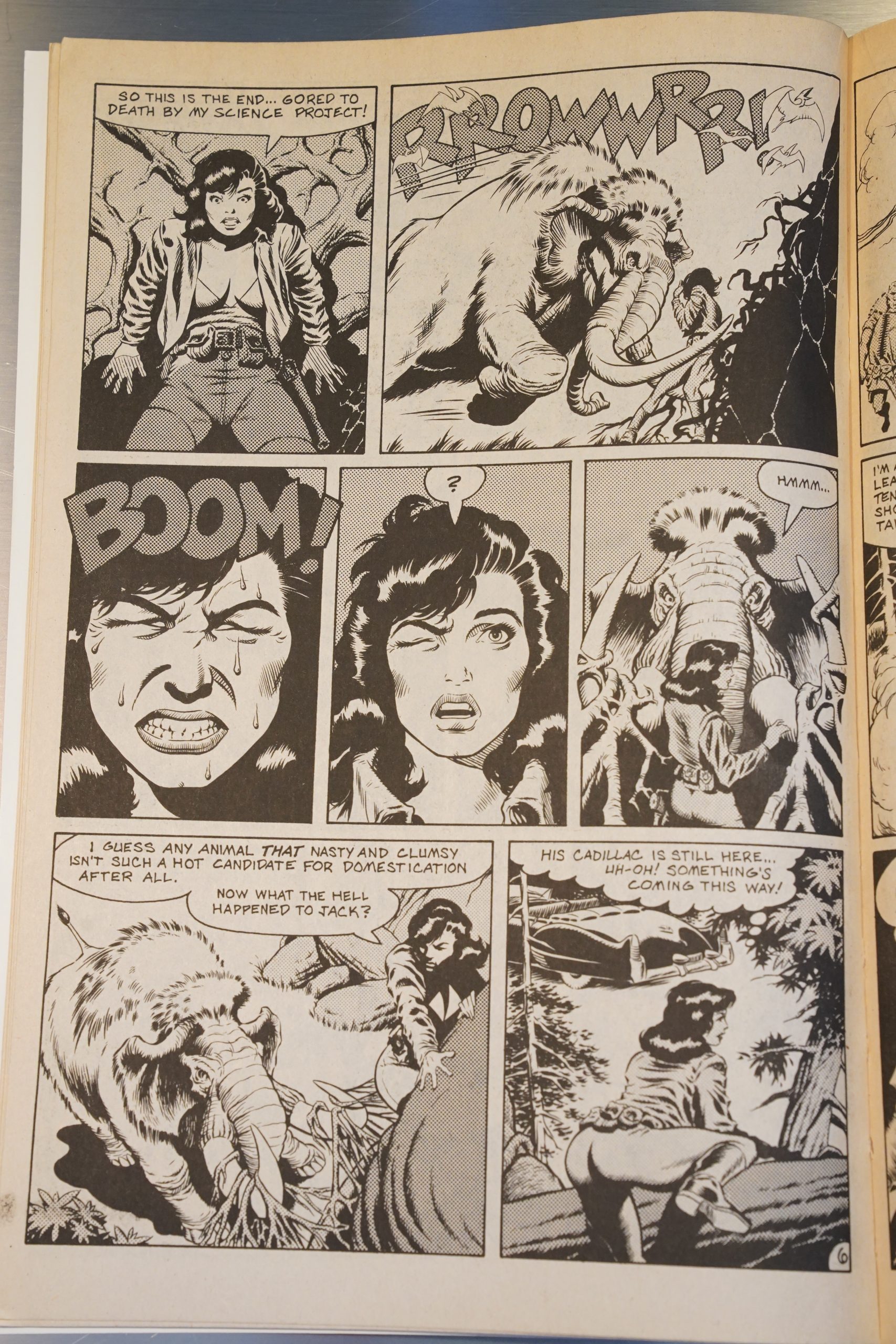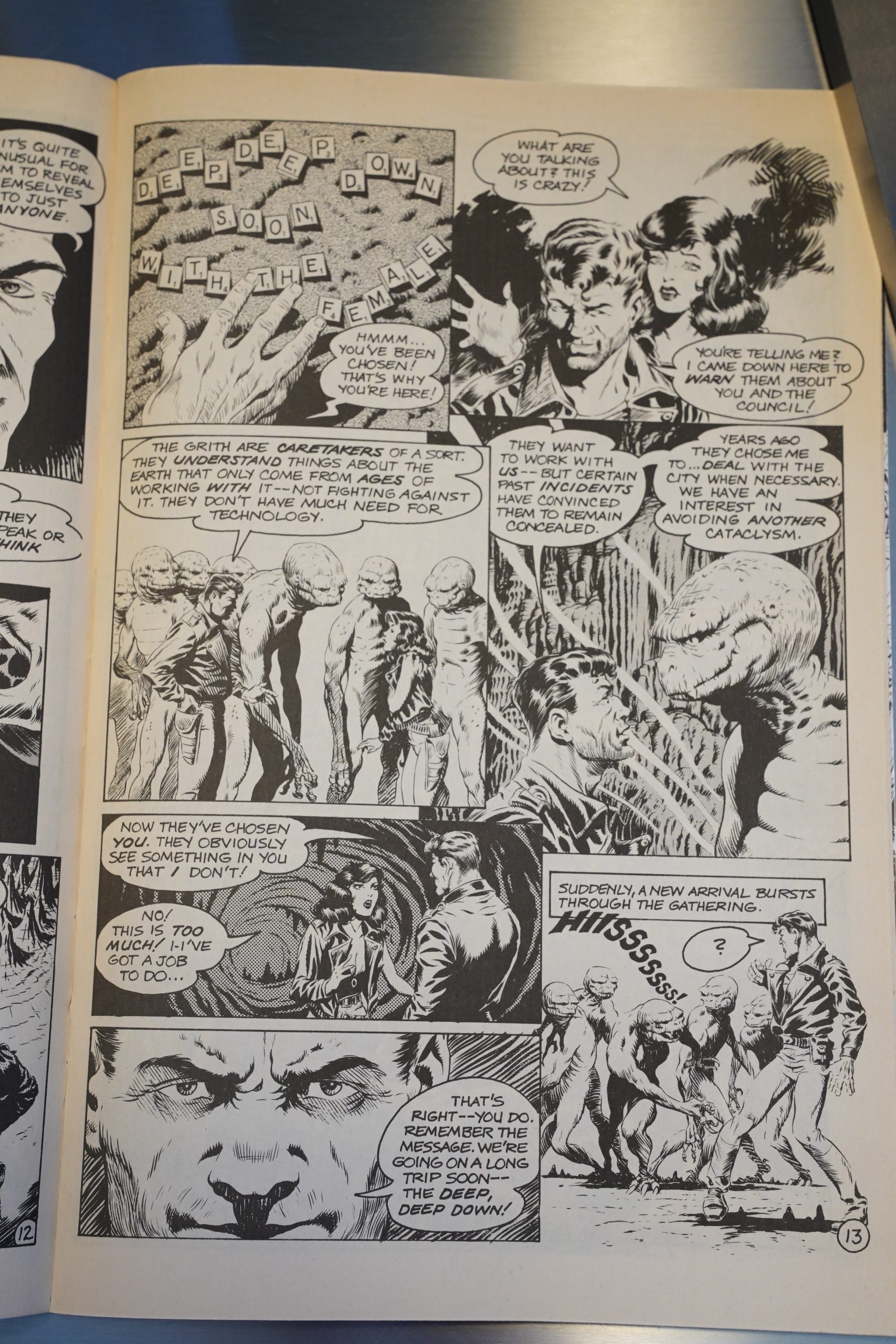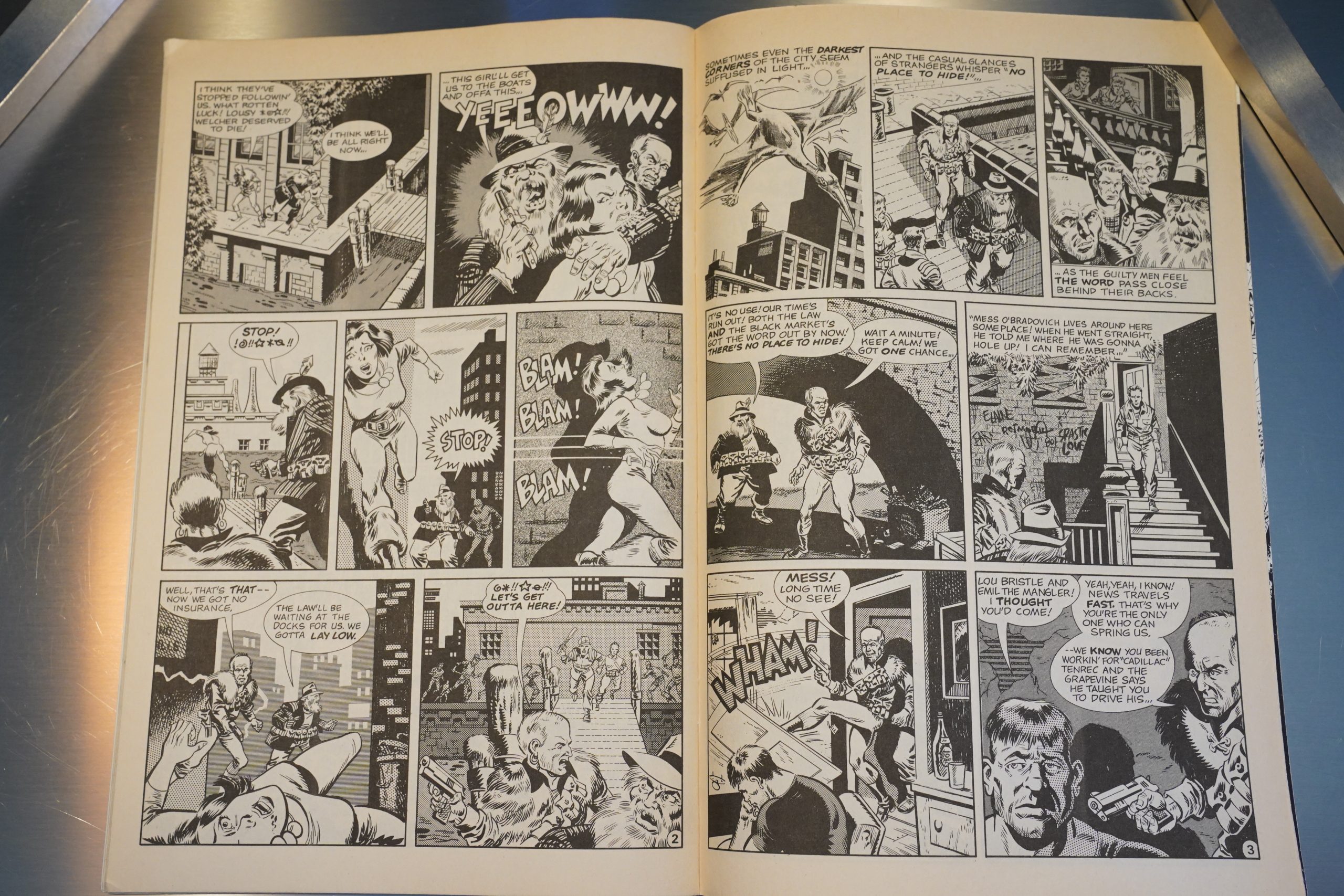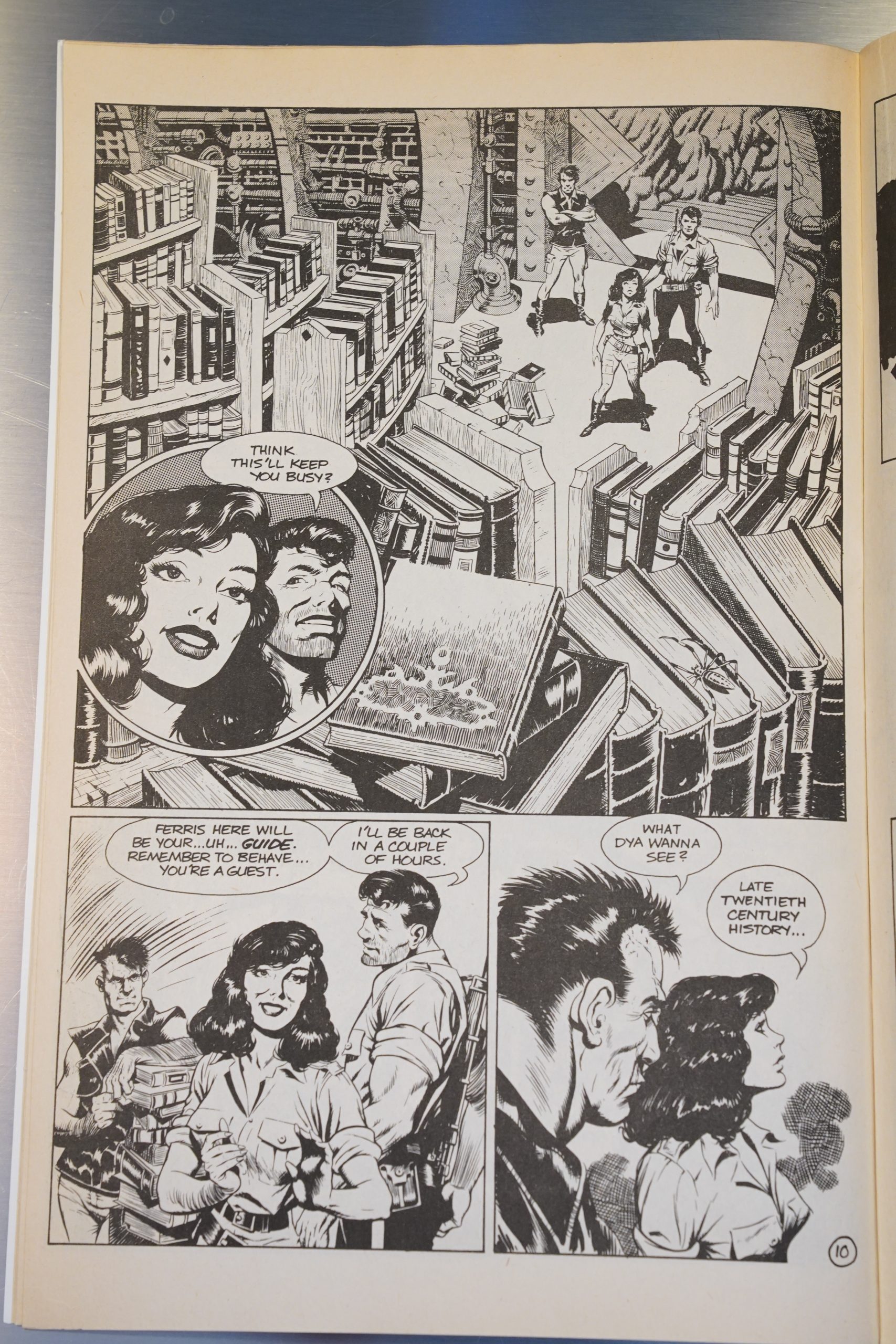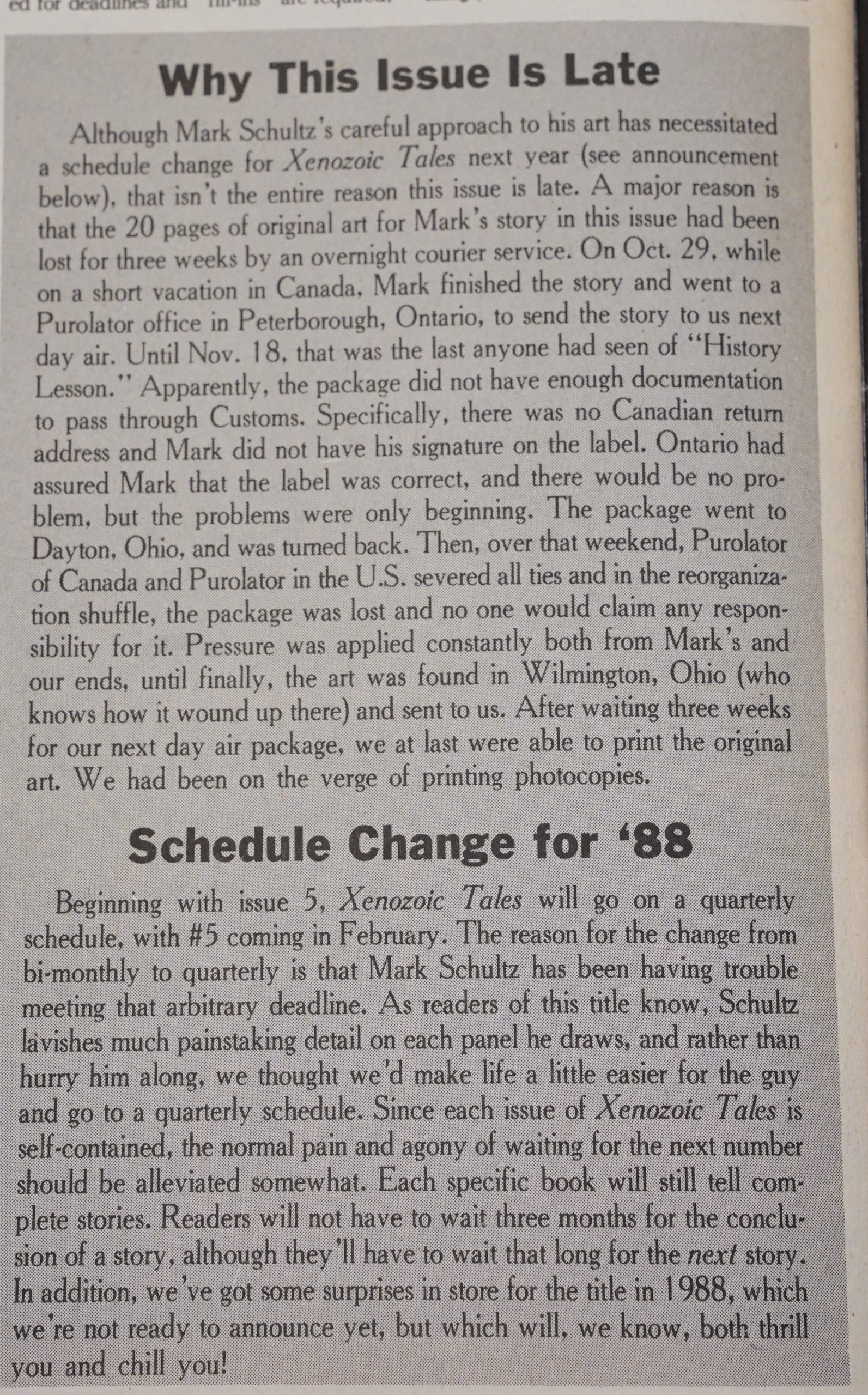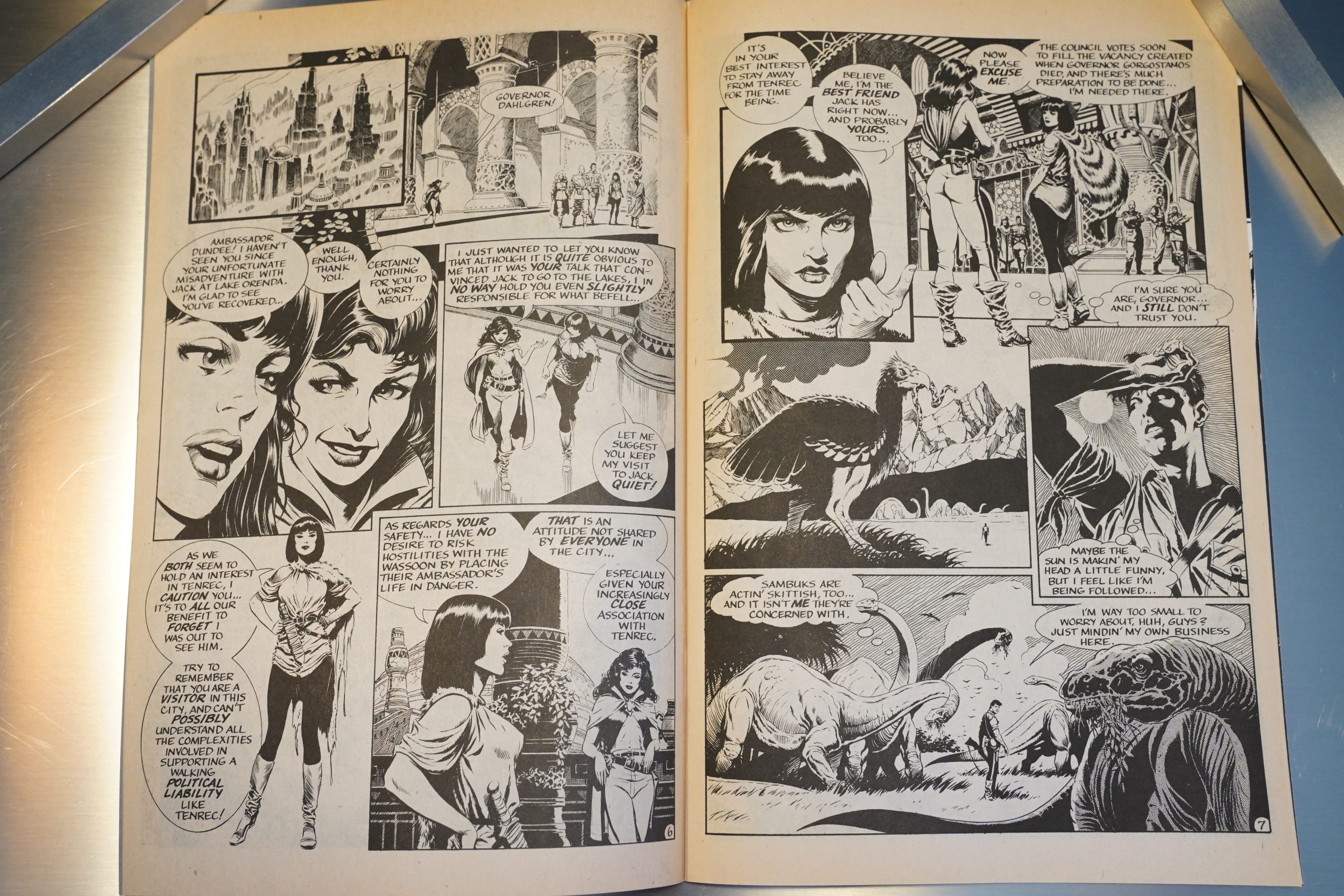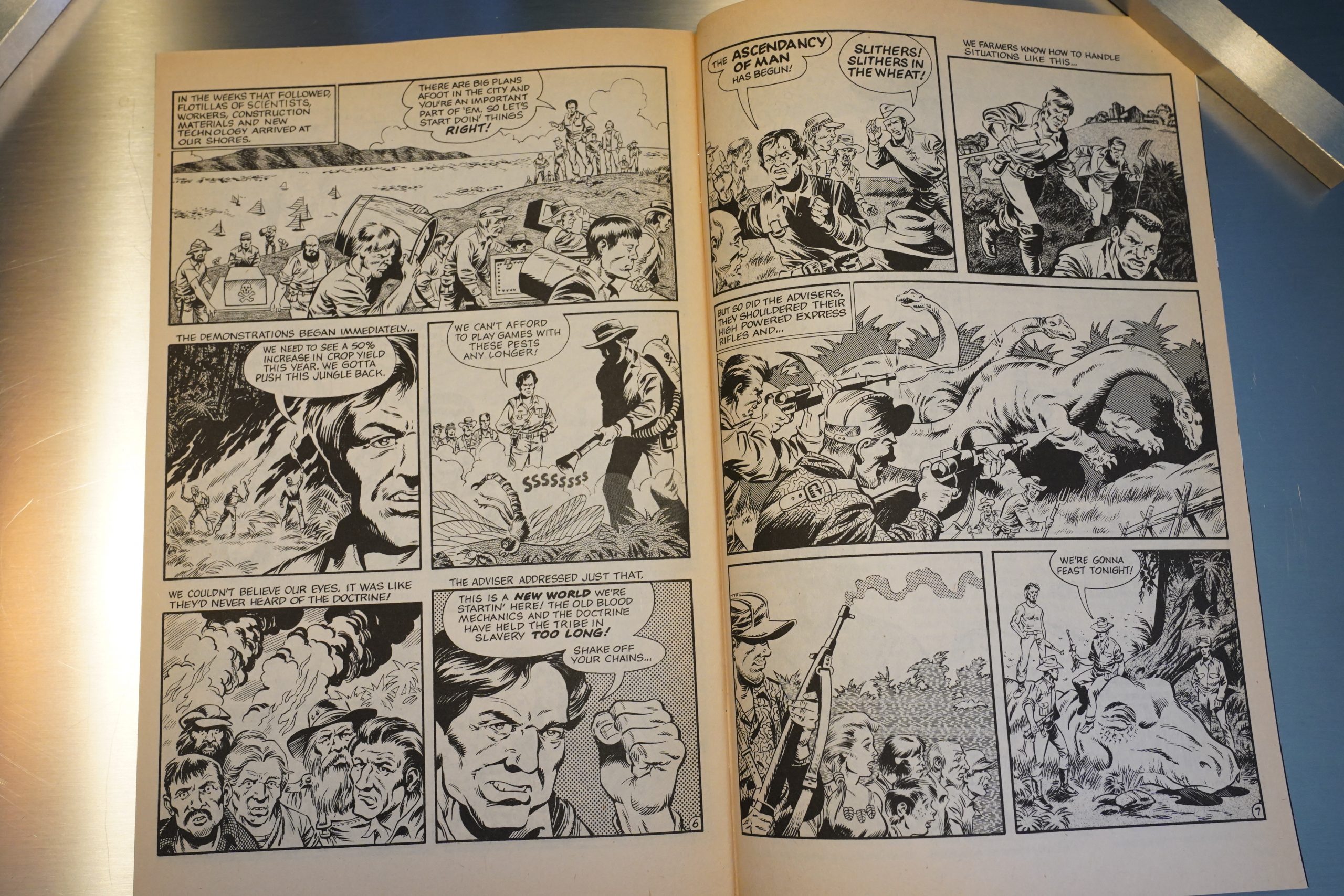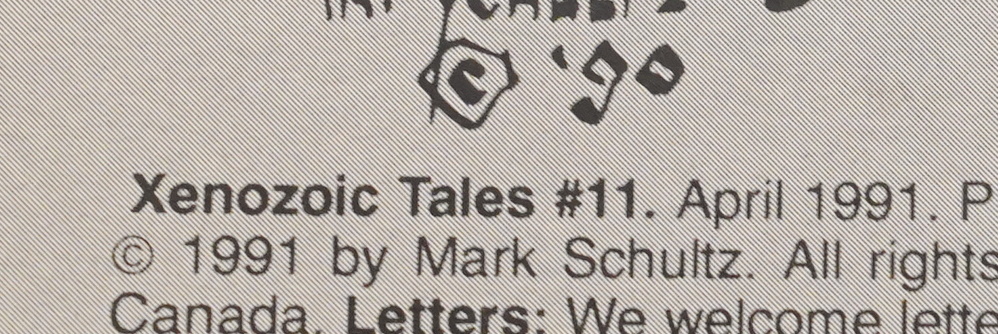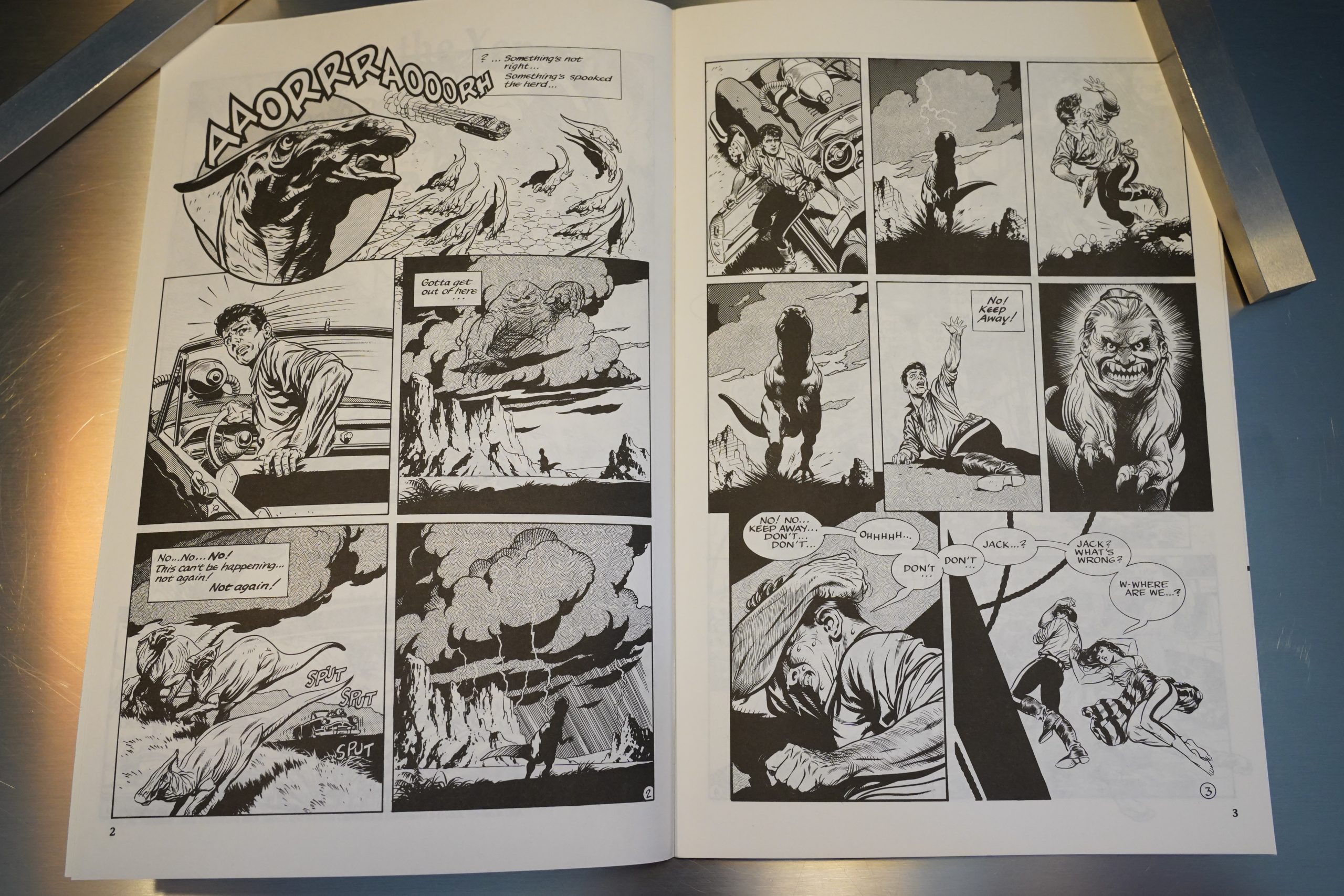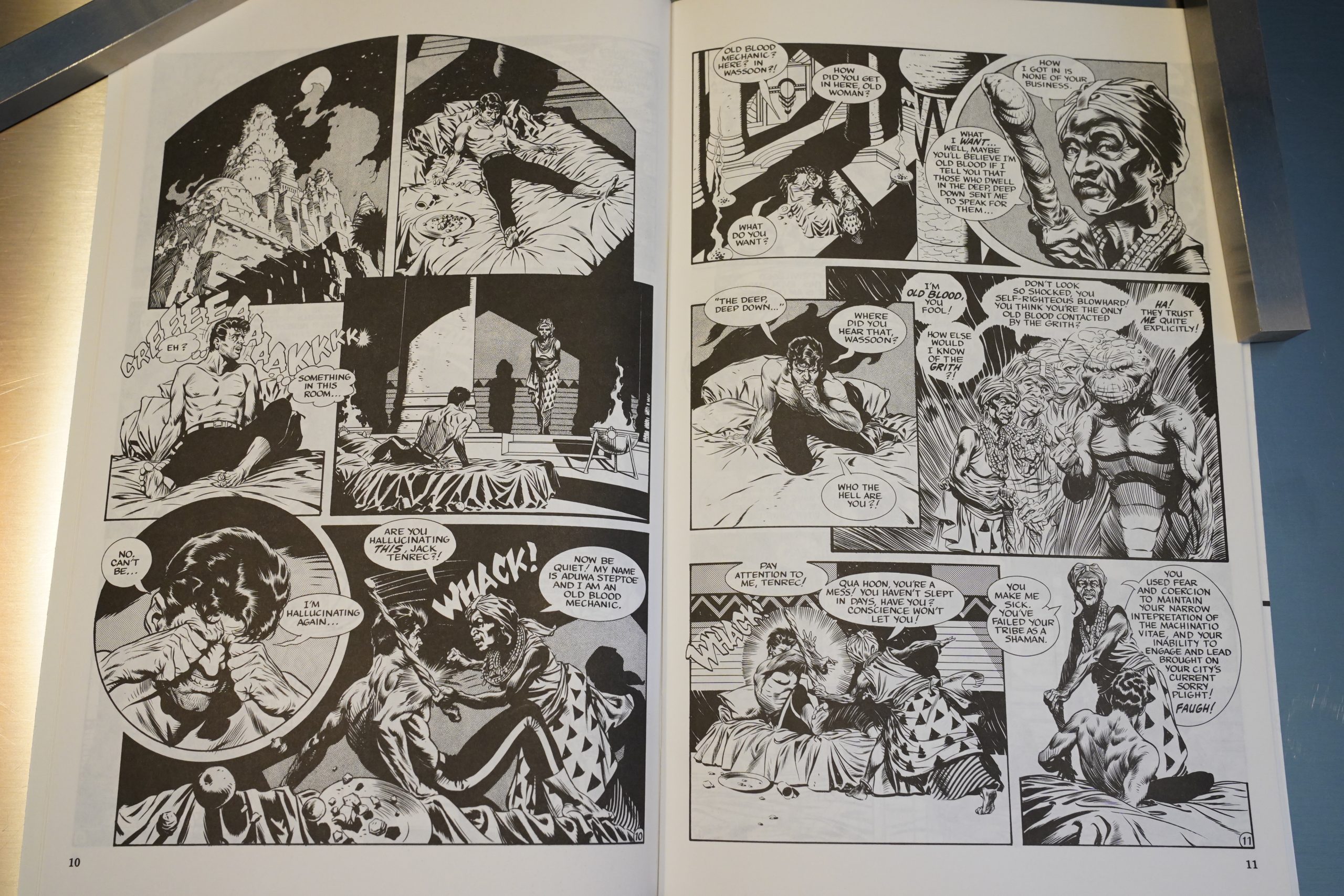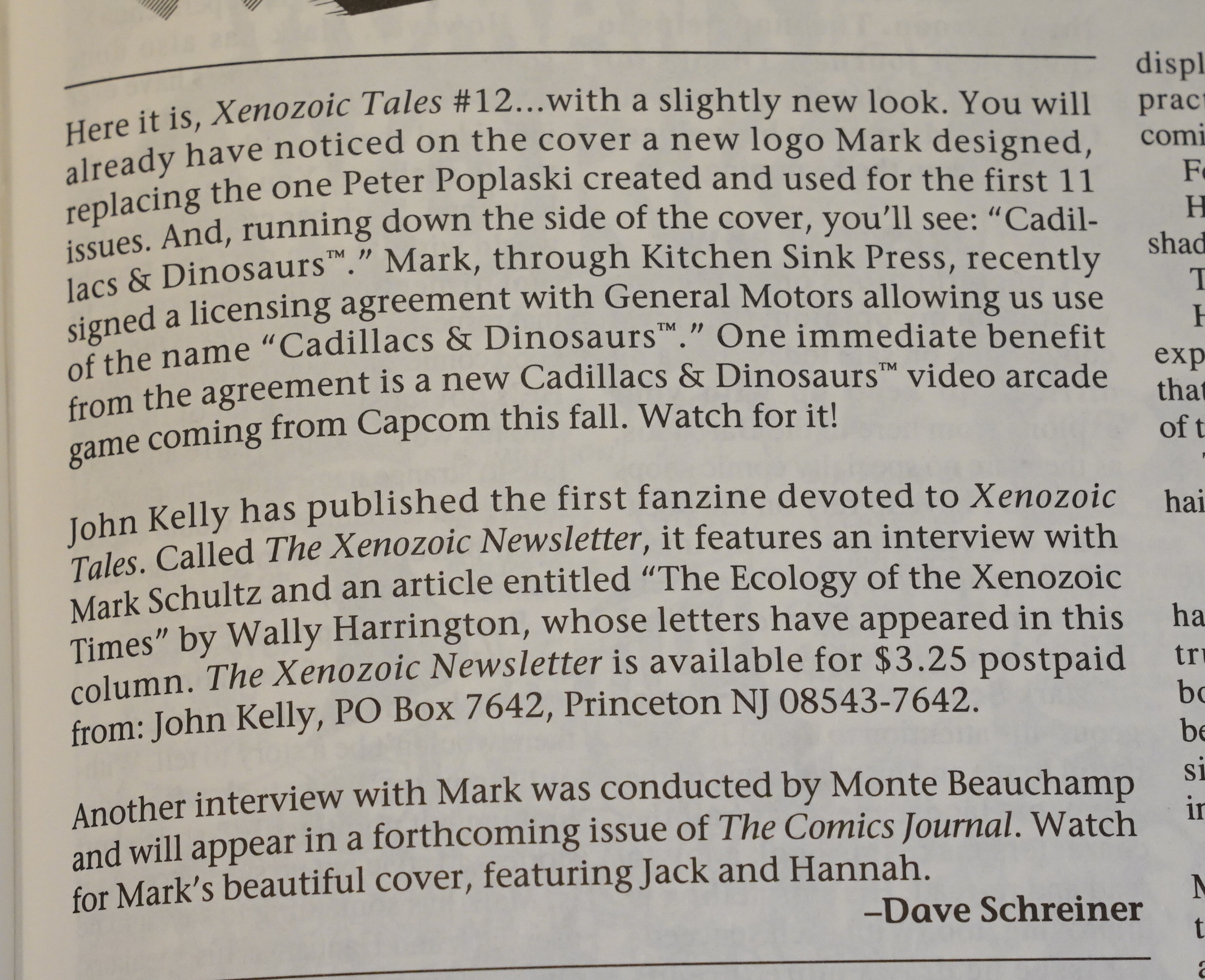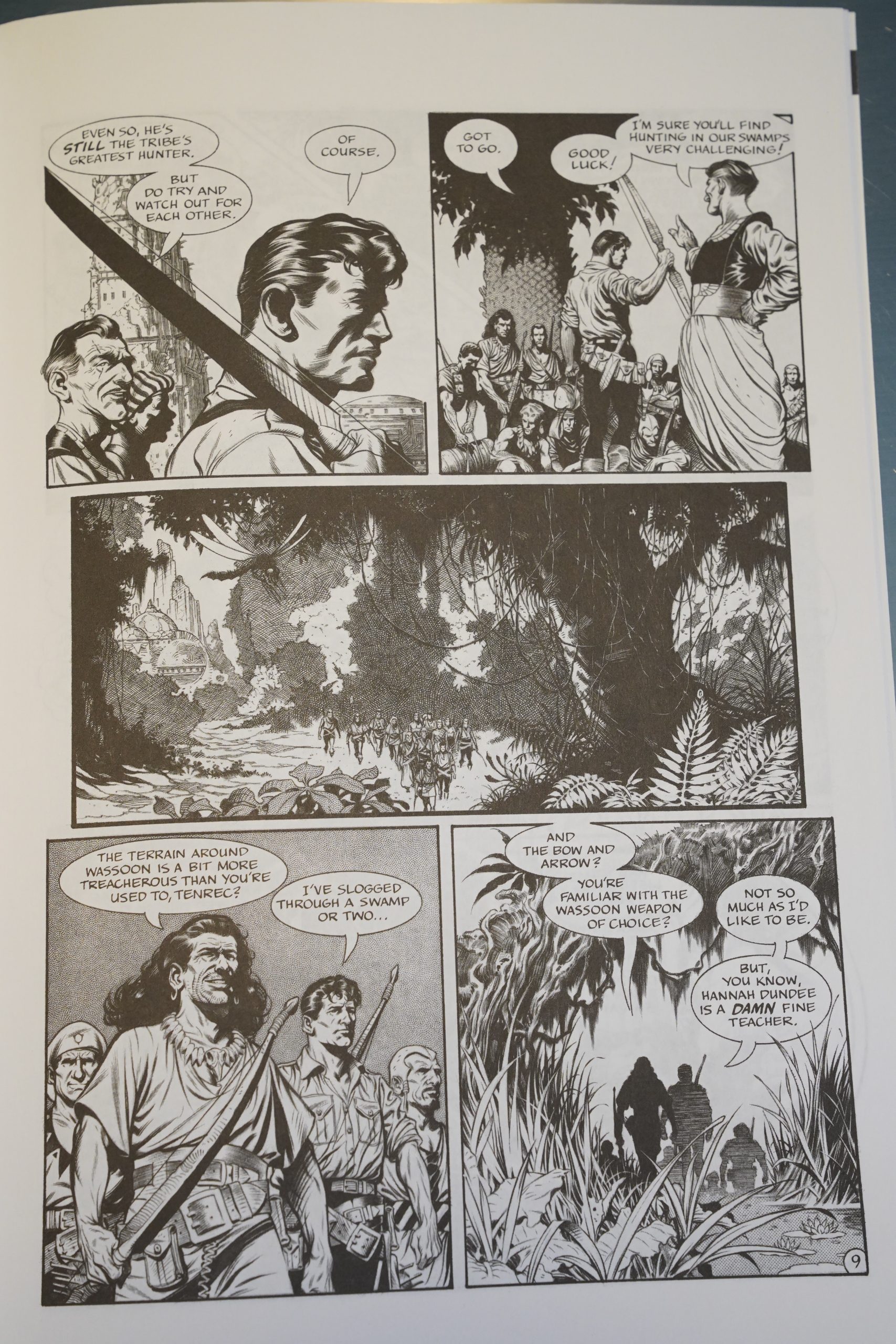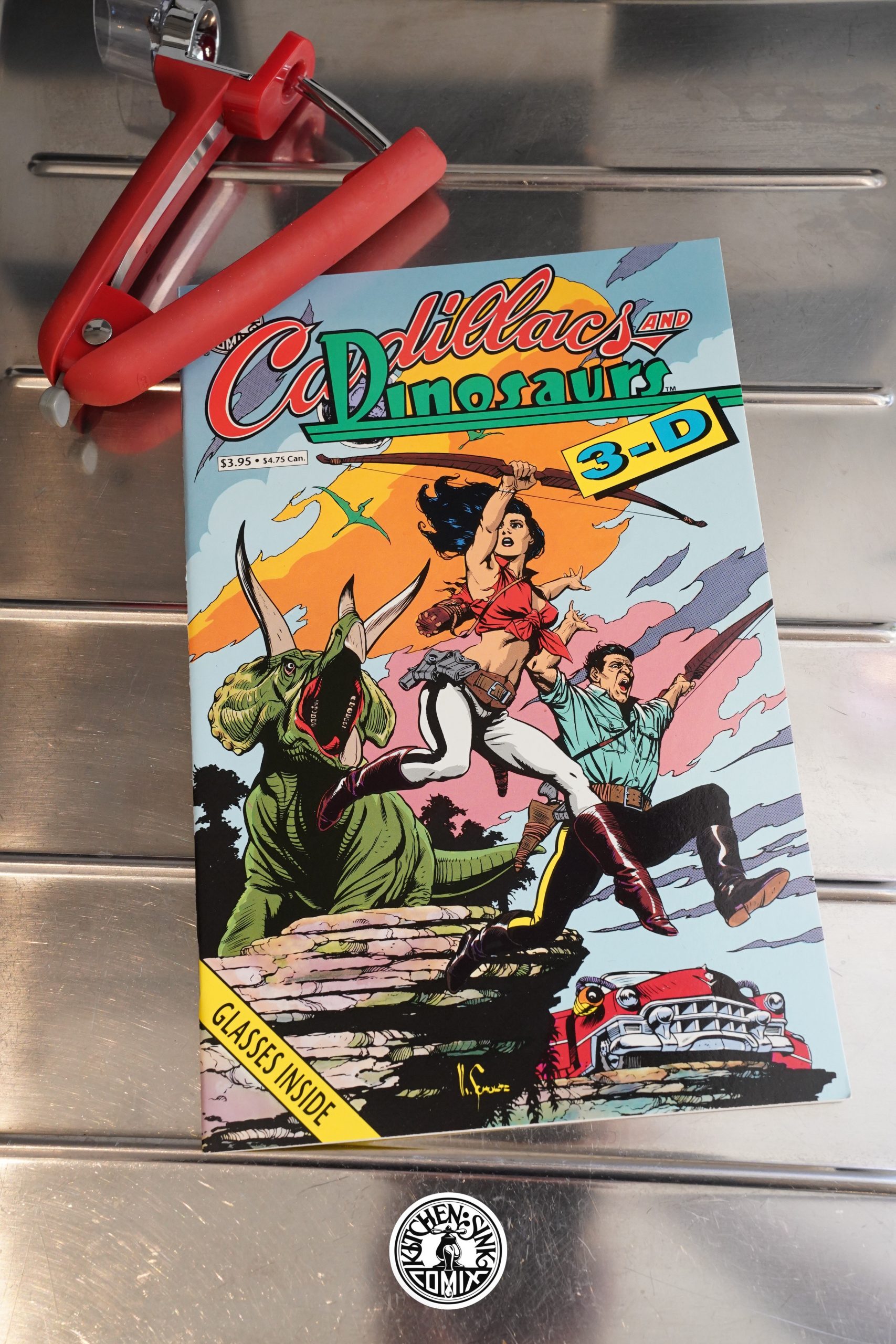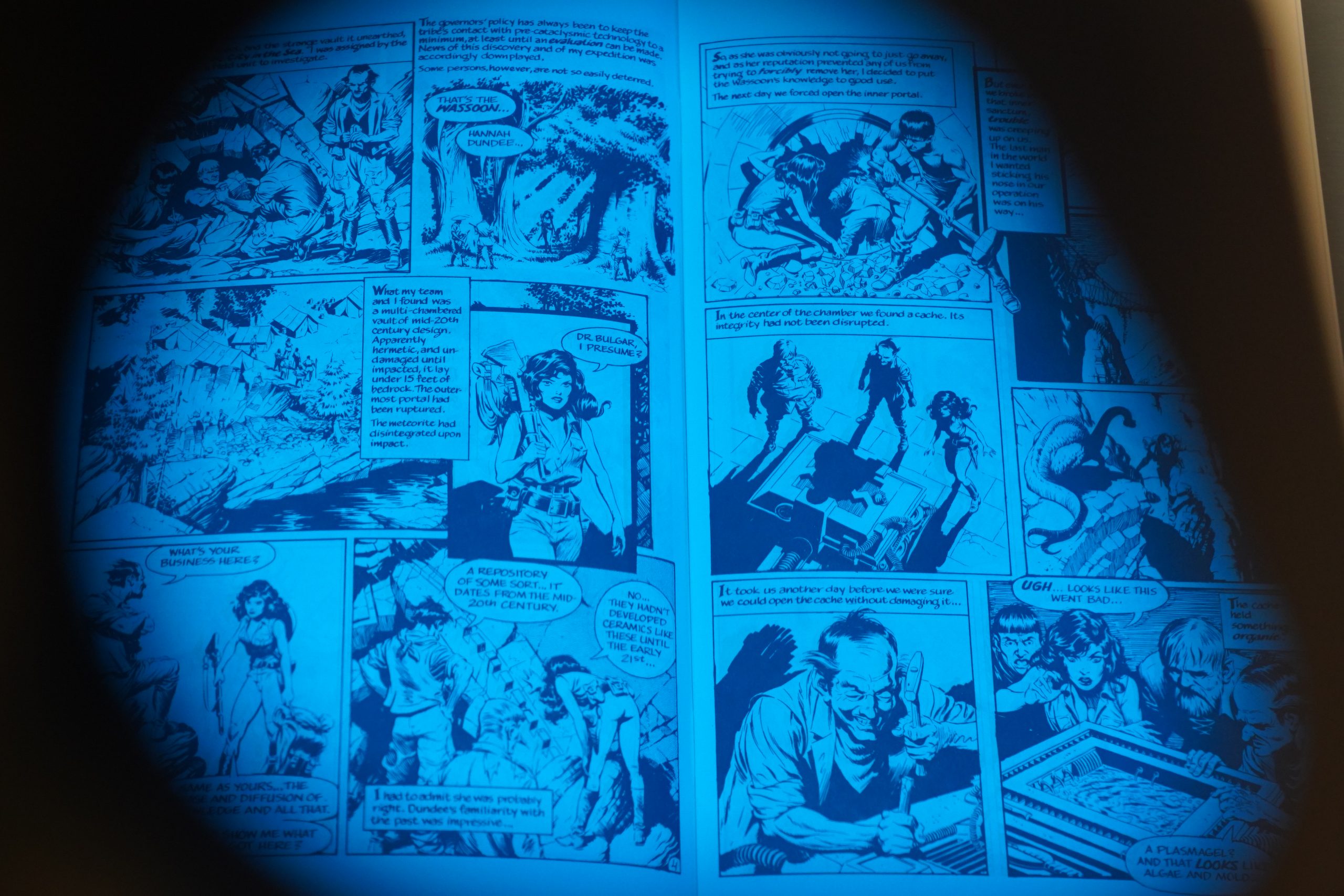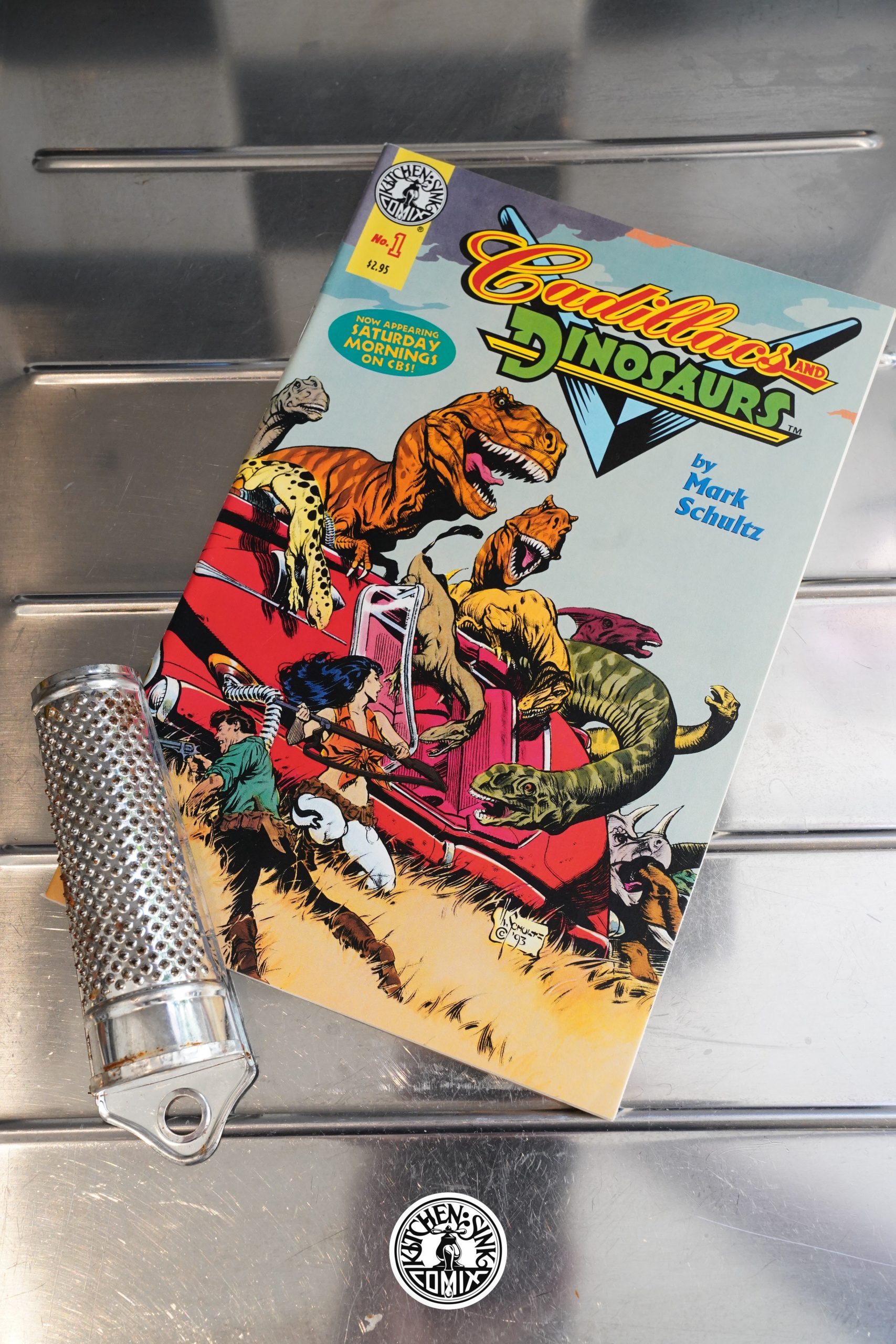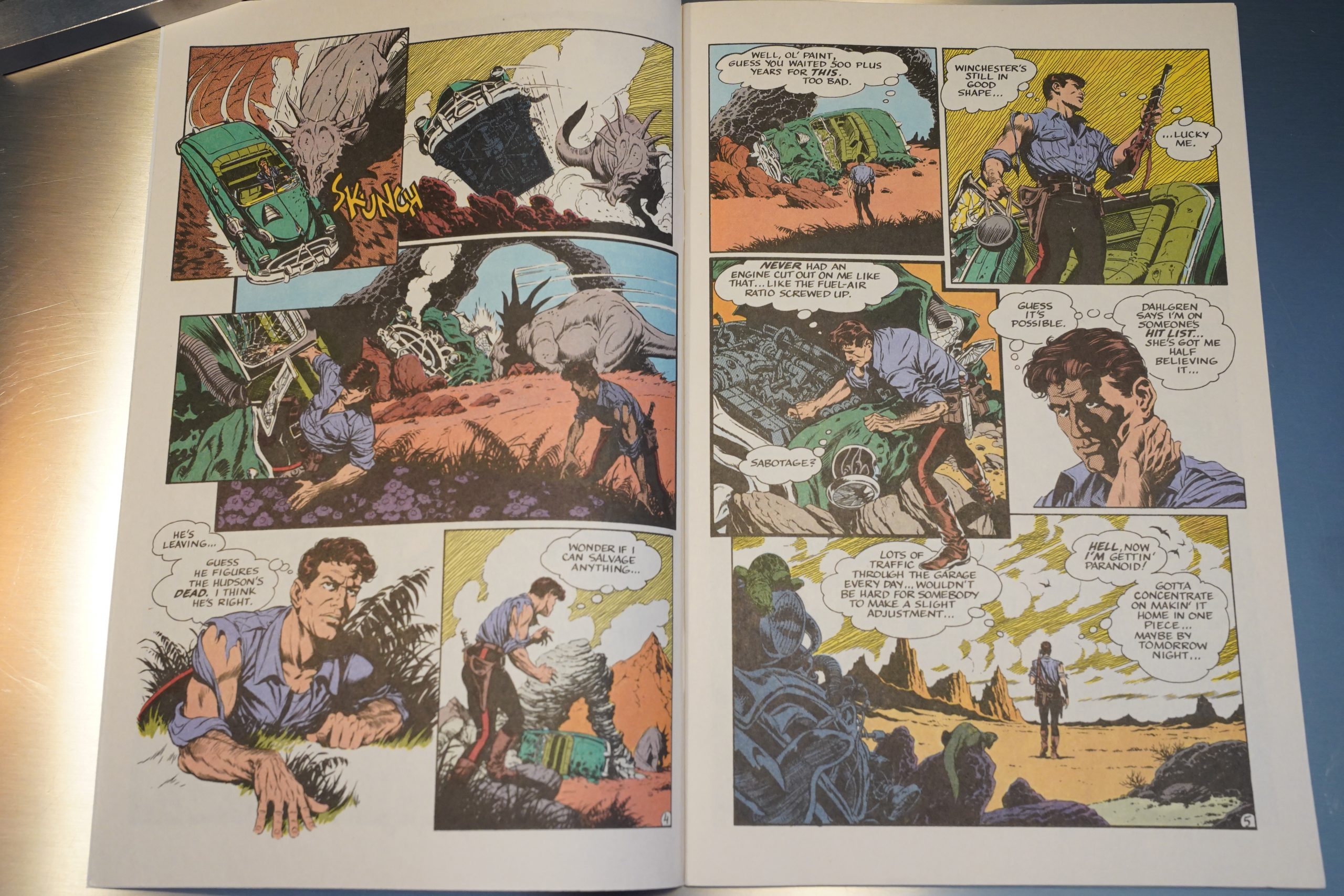Xenozoic Tales (1987) #1-14,
Cadillacs and Dinosaurs 3-D (1992),
Cadillacs and Dinosaurs Special Tyco Toys Edition (1993) by Mark Schulz with Steve Niles
Err… what happened? I was on a kinda roll with this silly blog, but then I took a two month unscheduled break. I had other things to do, I guess?
But let’s get back into it; there must be at least ones of people anxiously waiting for the next blog article to appear.
Right.
Right!?!
I had the earliest issues of this series as a teenager, and I remember being quite fond of it? I lumped it into the same category as Rocketeer, I guess — very attractively, aggressively retro comics.
Schulz is obviously very influenced by Wally Wood, but with more than a smattering of Al Williamson?
He does have solid rendering chops — these are very pretty drawings — but he’s rather vague about details like anatomy and body part size (note how the hero’s head in the sixth panel is much larger than in the other panels), and while he adds nice details like that deco lamp, note that thoroughly unconvincing staircase (all in the sixth panel).
And that “oops” pose is more Elder parody than anything else — do those thighs actually connect to anything? And his arms have more girth than his thighs?
You don’t want to study these drawings if you’re learning to draw the human body, is what I’m saying. Even if the rendering is really appealing.
Hm… this reminds me… have I nattered on about this before? YES!!! I’d forgotten I read the Marvel reprint of this series just two years ago. Completely.
My mind. I can’t even feel it going, but it surely is.
Anyway, I still agree with what I wrote then: This is a really entertaining series. Schulz manages to imbue his characters with a lot of character in a very efficient way — it sometimes seems a bit schematic, but it works. We’re carried along in a brisk way on adventures that are fun and exciting. It’s no wonder that it was almost immediately picked up for licensing by other media entities.
It’s got dinosaurs? And cars? And pretty women? In the future? Why not. It’s a bit generic as concepts go, but Schulz makes us believe in it.
OK, her waist might be a bit on the… er… unrealistic side, but she kicks ass.
And there’s beats of emotion — it feels like a well-rounded book.
Did I mention that there’s dinosaurs?
And hi-jinx?
In the editorials, they keep insisting that each issue is self contained, so it doesn’t matter that much that Schulz is very slow. But the thing is — they’re not. Self contained, that is. Schulz does not give us a steady state universe, where Tenrec goes out on a new adventure every issue, resetting everything every time. No, every issue gives us something new from this universe to ponder, and there’s a somewhat cohesive story being told.
Albeit very slowly.
Steve Stiles draws the backup features, and they basically flesh out the milieu — Schulz has a main storyline going, and you don’t need to read the backup stories to get it — but they add a richness. Not all of them do more than “and this is what the secondary figures did while Tenrec was driving around in his Cadillac”, though.
The story beats are pretty well worn, though. Like discovering a lost library. Has there ever been a storyline like this that didn’t have a lost library or a lost tribe of wise, alien creatures?
The post office ate the pages! But then hacked them back up again.
After announcing a quarterly schedule, the book promptly appeared on an every-six-month schedule for several issues. I’m guessing that Schulz was getting involved with merchandising and licensing and stuff? The Cadillacs and Dinosaurs video game appeared a bit later. (I’m amazed that they got GM to license the trademark, and I’m even more amazed that Schulz thought it was a good idea. It might give them some additional attention, but it means that the property is forever tied to GM’s whims, and that had to scare off anybody who was looking into making, say, a movie or TV series out of the material.)
Anyway, Schulz artwork continues to get better every issue. He seems to have started studying Hal Foster a lot, and women’s waists start looking more like something that could actually exist.
Oh, yeah, the storyline… I haven’t really said what this book is about now, have I? The theme is basically an environmental one — you have some good people trying to preserve a balance with nature, and then you have some evil capitalists that are in it for a quick buck, and are set on razing as much as possible. The above is from a back-up story illustrating what’s happening after the evil capitalists managed to take over the gummint.
Then the schedule slips to… once every year or so.
We get cardboard covers and white paper stock after all those newsprint issues. It looks nice, but the paper is very thin and has a lot of bleed through.
Since the book comes out so seldom (I’m guessing), Schulz starts dropping in magical people to tell our heroes what’s really going on. It speeds things up considerably.
Things seem to be buzzing business wise, at least.
Then the schedule slips to… once every two years or so.
Schulz continues evolving his art style — now with zip-a-tone and an enormous amount of cross hatching. He’s discovered Roy Krenkel? The nature scenes are very lush and pretty, but the faces seem to be deteriorating.
The series ends in the time honoured way for alternative comics: “Next!”
The fifteenth issue never happened, and I’m guessing it’ll never will. Things end in the middle of the storyline, and it’s not a bad one? It’s a shame, but it’s pretty entertaining reading anyway.
But wait! There’s more! First a 3D issue, and I was wondering how Schulz found time to draw one of these while being so notoriously slow.
The answer: He didn’t. This is just a 3D-isation of a couple of older stories.
And it’s not very good — it’s not Ray Zone. Very little seem to pop properly, which is a common problem with books not drawn with 3D in mind. But this is pretty bad, even taking that into consideration.
The very small 3D glasses don’t help, either.
There’s even more — this is a Topps special…
… and it, too, just reprints some older stories. But this time, in colour.
Oh, well.
The Comics Journal #117, page 62:
Xenozoic Tales is set during the 26th
Century where, following hundreds of
years of “geological upheavals” which
began as early as 1987, a new epoch in
earth’s history is well underway.[…]
One way of paraphrasing all of the
above is to note that Mark Schultz, a
careful student of the EC tradition, loves
dinosaurs, Cadillacs, sexy ladies drawn
in the Wally Wood idiom, stalwart heroes,
and the occasional gross-out. Xenozo(c
Tales permits him the opportunity to
jumble these elements together into a very
appealing porridge of science, fantasy, and
adventure. A look at the first two issues
(and a preview in Death Rattle #8), con-
firms Xenozoic Tales as an extremely
entertaining extension of the Wally Wood/
EC science fiction tradition.
I hestitate to use the term homage, since
that term has sometimes been used to
account for lack of originality. Yes,
Schultz’s art, like that of Rand Holmes,
is obviously derivative of Wood. More
accurately, though, Schultz’s art is as
eclectic an evolutionary porridge as the
world of Xenozoic Tales. There’s a Milton
Caniff influence, and Schultz’s staging of
action and his handling of the human
figure in motion is much freer than
Wood’s in his EC days. It’s closer to, say,
A1 Williamson. The important question
is, does the work have a tone and perso-
nality of its own? Well, Xenozoic Tales
frankly wants to be seen as part of the
EC tradition (both visually and philo-
sophically), but it’s certainly not a case
of mindless adherence on Schultz’s part.
This is a form and genre he obviously
loves, and, to judge from appearances,
he’s having himself a grand old time
working in the tradition.
Xenozoic Tales isn’t a simple
throwback. For all the reminders of
mankind’s contempt for the ecological
order of things—some of the sensibility
in EC’s Weird Science-Fantasy adapta-
tion of Ray Bradbury’s “A Sound of
Thunder” infuses Schultz’s work—Xeno-
zoic Tales has a cockeyed optimism.
Despite the banner to the first issues that
reads “Past & Future Meet In A World
Gone Mad,” there is a sense of promise
and beauty about the future to Schultz’s
vision that I don’t associate with EC. It’s
not a familiar post-apocalypse Earth as
a place ravaged beyond redemption or
where the lingering survivors grieve for the
past. This glimpse of the future has some
spunky fun in it.
There’s real storytelling charm and a
respect for nature in such stories as “The
Opportunists,” in which the heroine Han-
nah Dundee—a gorgeous babe drawn in
the sexy style for which Wood was famed
—fashions a scheme to use scavenging
Pteranodons as an early warning system
for the vulnerable fishing fleets, or “Rules
of the Game,” in which a hostile mam-
moth ironically becomes a savior to the
protagonists. (Hannah is an intelligent,
funny, capable figure: Schultz has gotten
beyond the pulp misogyny that kept crop-
ping up in the EC comics.)
Comics Scene Volume #2, page 54:
Schultz is clearly excited by all
his new ventures into TV and
merchandising, but also ac-
knowledges the pain of not being able
to work on his first love: The comic
book that has inspired all this
attention. “I’m still enjoying it very
much. I’m frustrated that I don’t work
any quicker than I do. I have lots of
ideas that I can’t get out because I’m so
slow in actually executing the art-
work.”
It’s an old axiom of writing that all
fictional action is character-driven,
and in Schultz’s case, it’s literally true.
“Originally, I would say my story ideas
pretty much dictated how the charac-
ters would behave, but as I’ve become
more and more familiar and comfort-
able with the characters that they, you
know, it’s a cliché to say that your
characters take on a life of their own,
but it is kind of true. They really do
define what happens in the stories
now. As I learn more about them, story
ideas are suggested. I say, this would
be an interesting situation to put Jack
in to figure out how he would react, or
Hannah has this character flaw here
that would be fun to exploit, and let
her work her way out of this one.”
The more character-oriented stories
of the current Xenozoic scripts are
“something I definitely wanted,”
Schultz explains, “because I’m a big
admirer of guys like Will Eisner and
Harvey Kurtzman, who did a lot of
that.” Xenozoic Tales has changed in
other ways as well. “The stories have
evolved from being the kind of twist-
ending E.C. type to more of an epic-
scale ongoing adventure.”
AH: Now about you, have you drawn
anything outside of Xenozoic Tales?
SCHULTZ: For comics?
AH: Yeah.
SCHULTZ: Yeah.. .well, 1 inked a
job. [laughs] I inked a back-up story
for Savage Sword of Conan.
Ail: What issue?
SCHULTZ: 1 think it was #132. Let
me see if I’ve got a copy of that here
. I think I do. It was a King Kull
story… yeah, #132. Pret-ty bad job.
AH: My collection ‘s just across the
room. If I can stetch and the phone
reaches… Ljust then, the tape stops
and we chat about the current state
of Conan while I dig out the issue and
turn over the tape].
I’ve got the book here, you and Val
Semeiks.
SCHULTZ: He did the pencils. It was
a Chuck Dixon story; I did the inks.
That was actually my first published
job.
All: What else have you done?
SCHULTZ: That’s it. Other than the
Xenozoic stuff and the first “Xeno-
zoic” story.
All: Didn ‘t you do the cover of Kings
in Disguise #3?
SCHULTZ: That’s correct, 1 did do
that: That was a lot of fun.
AH; How many Xenozoic tales are
there? I mean, do puforesee the book
‘ ending at #25 or something?
SCHULTZ: No. As long as I enjoy
doing it and as long as Denis wants
to publish it. As long as I can make
a living at it. At this point, I’m not
tired of it and I don’t have any agenda.
AR: Ijust thought perhaps there’s a
grand scheme imvlved and maybe you
could see the ending.
SCHULTZ: I’ve got several different
ideas if I did want to end it. I don’t
have any plans to do that in the near
future. I see it as an ongoing story
that’s just rambling.
I like to stay freshe I like to come
up with the stuff as I go along because
it keeps me interested. Maybe a char-
acter will start to develop in a way
that’ll be more interesting and differ-
ent than I uould’ve originally planned
if I planned everything out.. It might
be fresher and more interesting if it
happened organically.
Of course, sometimes I get into pos-
itionslike I am now. ‘I don’t have a
story idea and I one and I’m kind
of desperate. But I don’t like to box
myself in. I think I get bored with it
if I lavish so much time on everything
and knew everything that was going
to happen.
I’ve got general long range visions
of what the characters are going to do,
but like I said, I don’t want to be
locked into anything exactly. It might
develop differently.
Comics Scene Volume #2, page 55:
Schultz plans to keep right on
doing Xenozoic Tales, no matter
how long it takes him to get an
issue out. “I see Xenozoic Tales as an
ongoing project, into perpetuity, pretty
much like Hal Foster did with Prince
Valiant. I’ve purposely created a world
where I wasn’t locked into one type of
story, to keep me from getting bored
with having to do the same type of
thing over and over again. And as long
as people want to read it, I’m going to
want to keep producing it.”
Beyond depicting the Xenozoic
world, Schultz’s plans for the future
involve working on a project with one
of his artistic heroes, A1 Williamson.
As Schultz recalls, “A1 approached
[Marvel Editor-in-Chiefl Tom DeFalco,
it must have been a year-and-a-half ago
now, and said, ‘If there’s one thing that
really interests me to draw again, it’s
Flash Gordon. Is there any way you
can get the rights?’ So, Marvel got
Flash for A1 and he asked me to write
it. And I was just floored. It’s the
dream of a lifetime to work with A1
Williamson and Flash Gordon. ”
Aside from Flash Gordon, which
will be out sometime in late 1994 or
early 1995, Schultz has no concrete
plans to take on any new projects,
though he’s never short of ideas.
have several ideas for graphic novels,
self-inclusive stories that I would love
to be able to get to someday. But, boy,
finding the time for them, that’s the
problem. ”
The Comics Journal #150, page 144:
BEAUCHAMP: When Xenozoic originally came out, it nus
announced as a bimonthly. [Schultz chuckles) What
happened?
SCHULTZ: Well, I just couldn’t keep that schedule and do
the kind of work I felt comfortable with. Never having
done it before, I couldn’t imagine that I couldn’t do that
— badly underestimating the time and amount of physical
work that goes into doing this type of thing.
BEAUCHAMP: So rhen you put it on a quarterly schedule.
What happened there?
SCHULTZ Same thing. The first four or five issues, I was
working around the clock on the darn thing — I wasn’t
doing anything but working on it. Not around the clock
like Wally Wood would work around the clock, but 14
hours. Sometimes more — 16 hours a day, maybe.
BEAUCHAMP: How long did you keep that pace up for?
SCHULTZ Maybe a year and a half, maybe two years.
BEAUCHAMP: Did you get any flack from Denise about
all the time you were spending on it?
SCHULTZ: Well, that did create some tension. I wasn’t do-
ing much of anything except working on this, the idea be-
ing that I was building up for the future when I wouldn’t
have to work that much. It’s not like I was a workaholic
and I had a deep need to do that, or that I wanted to spend
the rest of my life doing that. I also always thought that
one day I was going to stumble onto the magic key that
will allow me to get these done quicker. That hasn’t hap-
pened yet.
I’ve started to think differently — I now consider what
I’m doing in the same way as an author considers putting
a book out: it doesn’t have to be done On a regular
schedule. I don’t look at Xenozoic Tales as a periodical.
And thankfully, neither does Denis. In fact, he suggested
this way of thinking to me. He said I was going to drive
myself nuts.
Topps published a nice issue series, but I haven’t read it. There was a cartoon series which was cancelled after one series, so I guess it wasn’t very successful. Sometimes a continuation is announced, but it’s never happened.
This is the ninety-first post in the Entire Kitchen Sink blog series.

